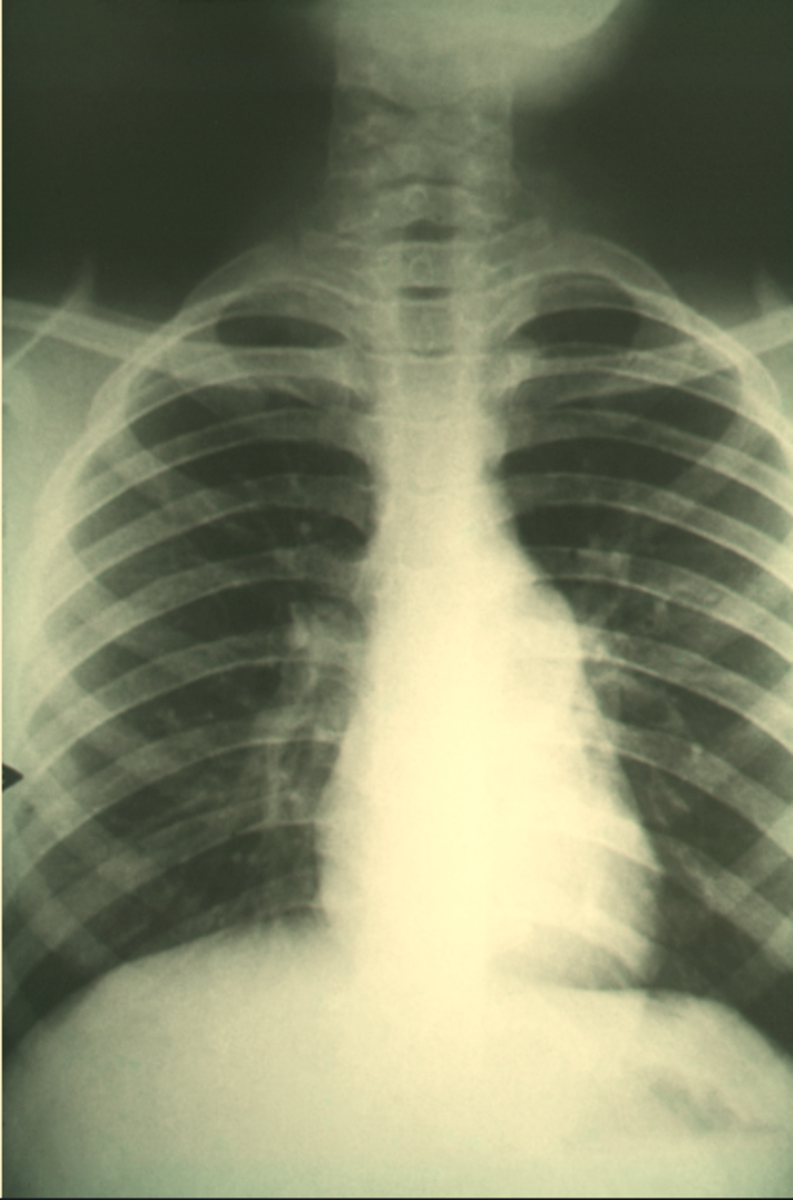Case Study: Are You Scared of 'Superbugs'?
Are Super Bugs on the Rise?

Abstract
Case Study: Are You Scared of'Superbugs'?
This research investigates how one institution in the Southwest Georgia region handles and addresses the emerging threat of Cryptococcus gattii. Specifically troubling, is a profiled case of a 47 year-old male patient living with HIV that was admitted to Southwest Georgia Memorial complaining of 'shortness of breath' and how uncommon it is for an HIV individual to have contracted the disease as compared to a healthy individual. The gathered data is of much significance not only because the CDC requires every health-care providers and laboratories in most states to collect information on each case, and report the information to the appropriate local or state public health authority on communicable diseases, but also the fact that Cryptococcus gattii now afflicts non-immunocompromised individuals outside the typically restricted tropical and subtropical geographical regions (Australia, Brazil, and southern California). This factor is puzzling in itself and thus indeed poses a danger to anyone who may potentially be exposed to the fungus and are there other factors influencing who (as far as immunity-wise) contracts the infection and their likelihood to overcome thereafter.
Introduction
Case Study: Are You Afraid of Superbugs?
Presently, there are about 75,000 scientifically documented fungal species, yet there are even millions more undiscovered. Some of these fungi have been shown to be beneficial to our health and well-being, while there are those that have proven to be fatal. Cryptococcus gattii (C.gattii) is a largely polyphyletic genus that consists of at least 37 different fungal species found in soil and certain trees, in particular eucalyptus trees (Dixit, Ashwin, Scott F. Carroll, and Salman T. Qureshi, 2009).
According to the U.S. National Library of Medicine National Institutes of Health, C. gattii was once considered a low-level pathogen until epidemiological changes of the infection due to its consequence of alterations in fungal ecology and biology, now illustrates its potential to cause serious human disease.
This organization noted that the first isolated C.gattii incident occurred from a leukemic patient in 1970, which at the time was described as a variant of C.neoformans. In the laboratory these two Cryptococci species can be distinguished on the basis of their capsular serotypes. However, even though C. gattii is closely related to C.neoformans, it appears to have a greater propensity to infect immune competent humans and for reasons not fully understood, C. gattii has acquired the ability to colonize new bio-geoclimatic regions and is responsible for these recent outbreak of infection among humans and animals in temperate regions.
To date researchers are bamboozled as to the increased recognition of C.gattii disease in non-pacific Northwest states. Since February of 2011, Southwest Georgia Memorial Hospital reported eighteen (18) Cryptococci infectious cases to the CDC and three of which were confirmed to be C.gattii. Sadly, of the three reported cases, two (2) are deceased.
Case
Case Study: Are You Afraid of Superbugs?
At the center of the diagnosis is Cryptococcus gattii- an infection that is commonly characterized by shortness of breath, cough, fatigue, fever, and headache which was also a few of the complaints that this 47-year-old male patient (with HIV-1) had upon presentation at the emergency room.
Generally these symptoms are estimated to begin anywhere from 2 to 14 months after exposure to the fungus and most oftentimes infect the central nervous system and cause inflammation of the brain and meninges (resulting in meningoencephalitis), as well as cryptococomas (fungal growths) in the lungs, skin, brain or other organs (CDC, 2010).
The attending ER care-provider evaluated the patient's vital statistics and promptly admitted him to the medical intensive care unit for further observation and therapy to follow as per his initial 'shortness of breath' complaint. Essentially for the identification of C. gattii infection, the analysis of spinal fluids from the infected site were collected and the series of tests that followed, presumptively identified C.gattii in the specimen; in addition to utilizing a third-party source for more definitive confirmation.
All of the patient's chemistry, hematological, and microbiological values were within normal ranges with the exception of a few values outside of reference ranges while hospitalized (seen in the illustrations below). After days of incubation and isolation of the source, the third-party laboratory facility confirmed and reported Cryptococcus antigen reactivity >1:256 to 1:16 to 'NG'- No Growth respectively all within several days. The reduced titer of the infection was contributed to aggressively administering anti-fungal drugs specifically geared towards HIV recipients.
Chest X-Rays With Mass Lesion
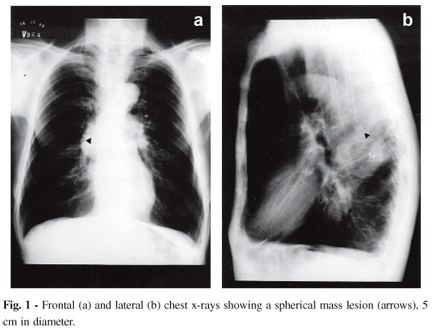
Your Thoughts!
Does medical treatment for Superbugs make you feel safer?
C.gattii Lifecycle
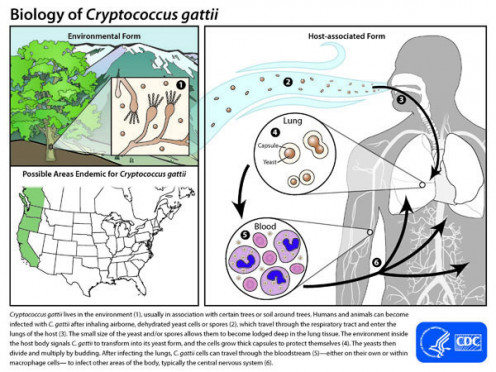
Discussion
Case Study: Are You Afraid of 'Superbugs'?
The emergence of C. gattii in the Southwest Georgia region is more than just an awareness, but alarming. Given that C. neoformans and C. gattii appear to share many of the same virulence factors, it is intriguing that C. gattii most commonly infects immune competent individuals while C. neoformans primarily infects the immune compromised host. But in this case, this patient contracted a disease that goes against the normal. Personnel at Southwest Georgia Memorial Hospital believed that the reason for this phenomenon is because his anti-retroviral medication worked so well that he appeared healthy and most likely susceptible to acquiring infections similar to that of non-immunocompromised individuals. But in Ashwin, et al research, they concluded that the immune compromised individuals may have had more environmental exposure to C. neoformans compared to C. gattii and therefore, contributes to the host genetic background becoming resistant to Cryptococci infections.
As noted, his lab results are consistent with other research findings. For instance, when certain microbes enter the meninges is it expected that the invading microbe will utilize some/most of the host's metabolic processes (by forcing the body to increase protein, glucose, etc. rates in order to function and replicate); as well as, the normal metabolic values he appeared to have even with a positive HIV status.
More details about this patient's background and lifestyle changes could have given an even deeper understanding as to why he became susceptible to this infection other than simply related to his medication regimen without disrupting his confidentiality.
Deadly Fungus Spreads
Laboratory Results
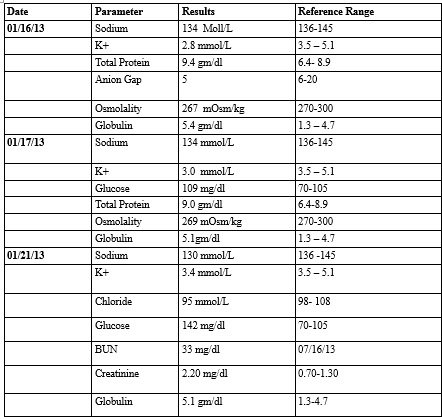
Patient's Clinical Laboratory Results
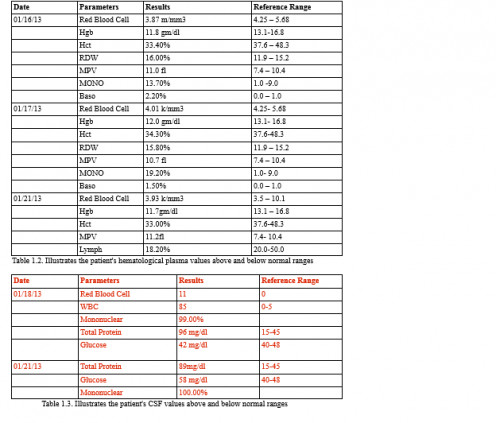
Conclusion
Case Study: Are You Afraid of Superbugs?
After several days of intensive therapy, the patient was released from Southwest Georgia Memorial Hospital and doing well. As for the other two cases, both had no travel history or outdoor activity that could have caused them to contract this infection. As noted, they succumbed to the disease even with aggressive therapy similar to that of the HIV patient.
When asked if any precaution or procedures have changed since the emergence of C.gattii, the answer is 'no'- the policies currently in place for infection control (as far as exposure) is adequate; with the exception of the microbiology department adding more test medias for specific identification of C.gattii.
I am astounded by the challenges that healthcare professionals face each day, yet they continue to persevere in order to save lives and put out fires. I will one day face the same challenges and I will just like my predecessors, do my very best for the greater good of all patients and the community as a whole.


